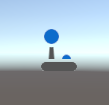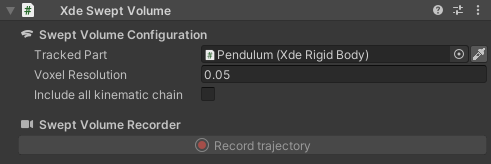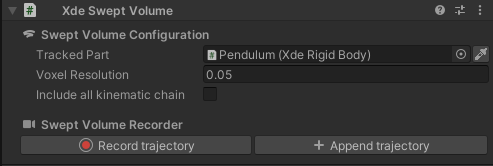Simulation Tools
When running a simulation it can be interesting to move or get information for testing and improving the scene. INTERACT provides several tools that can be used in Runtime mode.
Manipulator Tool 
This tool allows you to manipulate a physicalized object from the scene view while simulation is running. While simulation is running, this tool is very helpful if you need to adjust the position of your object in the scene. However the manipulator tool allows you to move your object according to its joint. For example if you have set a prismatic joint, the manipulator tool will manipulate that object by its translation axis.

How to use it?
As you simulate your scene in VR, go to the scene mode, click on the physical object you want to move, then the manipulation tool icon will appear and you can move your object. Simulation needs to be running in order to use manipulator tool.
Distance monitor 
The distance monitor allows you to monitor minimum distance between two sets of objects in real-time. It is useful to know precisely how far away objects are to avoid collisions, for example.
How to use it?
- Make sure your objects are physicalized.
-
Add the Distance Renderer component to an object in the hierarchy, no matter which one, as we will define the target objects in the component Xde Distance Monitor that is automatically added with the Distance Renderer.
-
Define the targeted objects to measure, by dropping the targeted RigidBodies.

-
Run the simulation and open the scene view to visualize the closest distance between your selected objects. Gap and positions of the closest points are displayed in the Xde Distance Monitor component.

Swept Volume 
A Swept volume is the space occupied by a moving object over its trajectory or motion path. It is useful to identify potential collisions or interferences in assemblies of multiple moving components.
INTERACT allows you to record the trajectory of moving objects with complex kinematics and collision detection. The swept volume can be exported to a .stl file which will be included into your PLM.
Where to find the editor ?
You have to add an XdeSweptVolume component to a game object in the scene where there the volume you want to track.
Setup tracked part and resolution
-
Tracked part : select the moving object to study (it has to be a rigid body).
-
Voxel resolution : Lower this value is, more precise is the computing. But it requires more performances from your computer.
-
If "Include all kinematic chain" is checked, the computing will consider all attached parts to assign ones.

Recording
When simulation is running :
- Start recording the trajectory by clicking on Record trajectory. Every motion of tracked parts is now recorded.
-
When motion path is over, click on Stop recording to generate the swept volume.

-
You can append movement to the trajectory by clicking Append trajectory. This functionality works the same way as Record trajectory.

-
The swept volume appears in your scene when recording is stopped. You can find a mesh and a prefab of your swept volume in Assets/INTERACT_DATA/SweptVolumes. The prefab is instantiated as a child of the game object containing the XdeSweptVolume component when simulation is stopped. The file name contains date and time of the record and the tracked part name.
Export the mesh
-
Export the swept volume into a STL File, you can go in the inspector of a Mesh Filter that contains the mesh of your swept volume. Then if you right click on the "Mesh" property, you could see "Export to STL" item in the drop-down menu.
-
To make the mesh to be in an STL coordinates system, the coordinates Y and -Z of all vertices are switched.
Swept Volume system coordinates
-
The swept volume mesh is assigned in your XdeSweptVolume component so its center coordinates is the position in world space of the component transform.
-
The swept volumes center coordinates in local space match the position in world space of the component transform.